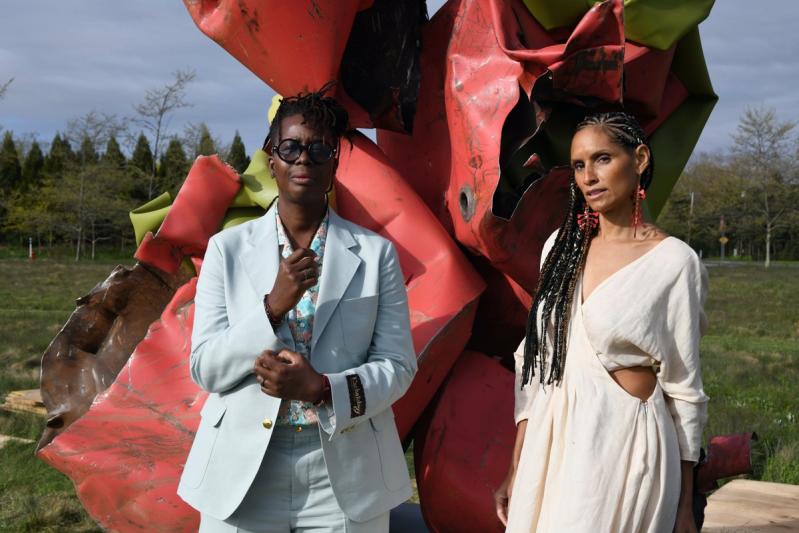If the Parrish Art Museum's current loan exhibition, "Set It Off," isn't tied to the region in any overt way, it might be time to reassess what those parameters mean for our regional museums and how they may no longer serve us as well as we assumed they have for so many years.
According to Susan Galardi, a spokeswoman for the museum, "As much as the museum has long been invested in presenting work by artists with a connection to the region, it has been equally dedicated to connecting to its communities of that region -- Latinx, Native American, L.G.B.T.Q., and Black communities." She added that the museum leadership thinks that "an artist doesn't need to be from the region in order to be relevant to the region."
In this case, the museum invited two outside curators, Racquel Chevremont and Mickalene Thomas, also known as Deux Femmes Noires, to show a mosaic of the wide variety of Black female voices currently working within and without the international art world. At the same time, each was mindful of the architecture of the Parrish's Water Mill building and wanted artists who could respond to its interior and exterior spaces.
Ms. Thomas's work is as varied as the artists she chose for this exhibition but centers on portrayals of Black women and issues of race, sexualization, beauty ideals, and a male-dominated history of art. Her collages are formed by her own photography, painting, and appropriated images.
Ms. Chevremont is an art consultant and curator for television shows and films as well as gallery exhibitions.
The six women whose work is on view address different themes across multiple mediums. The curators said they were chosen for "their unique artistic language, for forging their own path, and creating work that transcends traditional formal and art historical structures."
Speaking of multiple mediums, a good place to start is with the installation of Kameelah Janan Rasheed in the double gallery. Taking over an entire wall, "Primitive Hypertext II" uses Xerox, acrylic paint, pen, acetate, and single-channel video to create a piece that demands engagement from the audience as it follows footnotes in the snippets of text on the wall to corresponding visual elements.
These elements, incorporating themes from her work as a whole, are examinations of the role of poetics or language formation, politics, and pleasure in "Black knowledge production, information technologies, [un]learning, and belief formation." The messages it conveys may not be entirely clear, but the overarching sense seeps in as viewer becomes participant.
In the same room in similar tones of black, white, and gray are the acrylic paintings on canvas of Torkwase Dyson. These paintings are tightly structured, with white lines imposing borders in the compositions, which often feature rectangular shapes in what could be walls, diagrams, or schemes for building plans. Other times they appear fully nonobjective but seem evocative.
It is not surprising to discover that the artist is thinking about connections between architecture, infrastructure, and ecology as well as the spatial awareness of people of color. Although together they read at first as monotone in nature, once the viewer slows down and takes in each individually, the paintings begin to reveal just how much depth each composition conveys.
The art in this exhibition is displayed not only in discrete rooms, but in the museum's more open areas. The artists chosen for those spaces tend to dominate them.
Kennedy Yanko's commanding sculptures are an amalgamation of found objects from salvage yards and dried paint skins. There is a tension in her work with the hard edges of crushed metal and the deflated and flaccid "skins" formed by the dried paint. Each tells its own story of brokenness and vulnerability as their contrasts create tension within the visual elements and structures of each work.
Opposite, Karyn Olivier has installed "How Many Ways Can You Disappear," a tangled mess of salt-coated lobster fishing rope placed on the floor beneath a collection of hanging colored buoys. "I was thinking of the salt's history in relation to trade/currency, particularly the practice of trading slaves for salt in Ancient Greece," the artist said.
On the walls, she has asphalt-and-tar-encased photographic inkjet prints mounted on acrylic. In some cases the photo image is a tiny window in the overall presentation, in others it dominates. The more specific the subject of the image revealed, the more specific the piece's title is. There is a sense of both personal and universal memory and history in this work as well as a representation of consciousness and how we often bury or obscure things with other remembrances.
Back in the galleries on the south side of the building are the works of February James and Leilah Babirye, each occupying a room of their own. Ms. James's space is full of haunting figurative bust portraits on paper and canvas in acrylic, oil, liquid graphite, watercolor, and other mediums. There is a lot going on, but the artist has deemed it all one installation, "These Are My Ghosts to Sit With," consisting of "28 portraits and a cardboard living room that is encased within a wooden frame and set in the center of the room," as the museum describes it. The room appears to exist as a faded and blurred memory as the portraits of those who may have once occupied it look on.
Ms. Babirye's totemistic sculptural assemblages bring forth complex and abstract ideas such as human rights. Her wall hangings feel historically resonant but are formed, as are the standing pieces, from modern urban detritus. She further enhances the pieces with embellishments that she has burned or otherwise transformed. "Through the act of burning, nailing, and assembling," she has said, "I aim to address the realities of being gay in the context of Uganda," which recently passed an anti-homosexuality bill. According to the museum, the pejorative term for a gay person in her native Luganda language "refers to the portion of the sugarcane that is cast off and discarded."
"Set It Off" is defined in this context as meaning doing "something significant, with intensity, or with a hurricane-like force; or to change an atmosphere for the better." Examining each of the artists' practices, it is an apt organizing theme for the show. Employing a different meaning, it could also be seen as casting the museum in a different direction, one concerned with the inclusion of voices that may not have had historical agency within the walls of the Parrish, changing its context for the better.
The exhibition will remain on view through Sunday.



